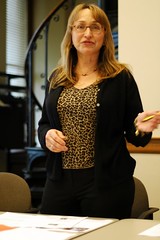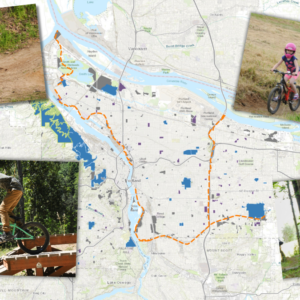The Rails-to-Trails Conservancy (RTC) stopped in Portland recently to meet with advocates and policy-makers to rally support for an ambitious congressional funding campaign.
As I reported a few weeks ago, the RTC hopes to secure $2 billion in the next Federal Transportation Bill to fund 40 communities to the tune of $50 million dollars each to “improve bicycle and pedestrian mode shift”.
The program would be an expansion of the Nonmotorized Transportation Pilot Program which gave 4 cities $25 million each in the last transportation bill.
“Portland is one of the cities we’re talking to very early on in this process.”
–Laura Cohen, Western Region Director for the RTC.
Around the table at the meeting in City Hall last week were reps from PDOT, ODOT, Metro, Alta Planning, the BTA, the Community Cycling Center, and the Portland Oregon Visitors Association.
We were given a formal introduction to the RTC’s 2010 Campaign for Active Transportation by their Western Region Director Laura Cohen (in photo, above) and their Manager of Trail Development, Benjamin Gettleman.
They called their campaign an “exciting federal policy opportunity,” and said they are very interested in partnering with Portland to make it happen. Cohen said,
“We brainstormed years ago and identified some communities we felt could really lead the way. Portland is one of the cities we’re talking to very early on in this process.”
In August, the RTC will bring their annual convention, TrailLink, to Portland. Benjamin Gettleman said that event would be “a pivotal launch” for this new campaign.
City bike czar Roger Geller said the time is perfect for Portland to get an infusion of cash for bike facilities.
“We’re particularly well-positioned now because we’re in the middle of updating our Bicycle Master Plan and we’re really thinking beyond the standard American plan development.”
Geller said Portland is poised for exciting progress, and that all we need is cash,
“We’ve got the leadership, the expertise and the desire, but what we need is the money.”
The meeting turned into an interesting discussion about the challenges Portland faces in improving bike facilities and the potential opposition (if any) if this funding opportunity materializes.
One topic that came up was the geographic consideration; if we did get this $50 million, where should it be spent? Should we spend it in a relatively small area, and create an experimental bike utopia, or should we spread the money around several small projects across the entire region or state?
The geographic scope is a major question, particularly because many of the political players are from down-state. In the words of one ODOT rep,
“Creating a Shangri-La in Portland, has ripple effects throughout the state, but I’d like to grow it beyond Portland.”
A broad geographic focus would carry more weight politically, but it might make it harder to demonstrate quantitative improvements in bike mode share.
Laura Cohen suggested another option would be to focus on a thematic concept, like focusing on improving connections to mass transit. Other topics discussed were the importance of connecting existing routes, whether or not to spend the money on safety/engineering improvements vs. livability, and how this money could help push Portland into the proverbial “Tipping Point” of bike use.
At this point, the RTC is just garnering support and feedback for the campaign and the true test will be convincing members of Congress to make it happen. If/when it does, I think there’s a great chance Portland could end up with a piece of the pie.








Thanks for reading.
BikePortland has served this community with independent community journalism since 2005. We rely on subscriptions from readers like you to survive. Your financial support is vital in keeping this valuable resource alive and well.
Please subscribe today to strengthen and expand our work.
I’d like to check the box for counting on the ripple effect. Besides being the highest concentration of bicyclists statewide, Portland is also increasingly a canary in the coal mine for outsiders looking to find out what works/doesn’t.
At the same time, I’d like to see the funds used in more of a transportation-centric manner than past projects. Rather than running scenic trails to everywhere, how about a bike bridge over both the river & industrial zones? (chanting: bike bridge bike bridge bike bridge)
I would like to see some of the money spread around the region or state. One project that comes to mind is the C-Z Trail from Scappoose to Vernonia.
http://bikeportland.org/2007/03/07/vernonia-poised-to-become-velo-nia/
Perhaps I missed something, but is RTC’s main focus to convert rail lines to trails or is this just part of what they do? Seems like we’ll be using rail more in the future as the oily stuff dries-up, so I don’t think I can support converting them all to bike trails.
-Ian
Wouldn’t it be great if the rails to trails folks could figure out a way to connect the Historic Columbia River Highway from the area around Ainsworth State Park to the bike/pedistrian path at Eagle Creek; and from the end of Cascade Locks to the Mosier trail head in Hood River. Riding through this part of the gorge, all the way to the Rowena Crest is amazing, particularly in the spring and early summer when all the wild flowers are in bloom and the traffic is light. Unfortunatley, having to ride on I-84 between these points SUCKS (although worth it in the end just to do the ride).
I’m still not convinced that ripping up tracks for paths is a long term wise decision. I enjoy my bike path every day (Sunset highway bike path). However, I also know that the Max and street car are my other route when it is too rainy or I’m just lazy.
These tracks could someday be streetcar lines, or Max tracks. I feel those offer everyone an alternative way to commute. Bikes are great, I couldn’t live without my ride to work, but I know in 15-20 years I’ll be too old, to ride the same route I do every day. My wife still needs to take our daughters to day care, the bus/train is the only alternative way to do that right now.
We’re entering a time where we’ll need to rethink how we move people and goods. And rail is one of the most efficient. Ripping up the tracks just screams of the day when the car makers bought-up all of the streetcar lines so they could rip up the tracks for cars.
~n
Ian,
RTC does much more than rail-trails. Perhaps they should change their name! Seriously, they are the largest and most powerful bicycle and pedestrian trail lobby group in the country (rails or no rails).
======
bottom bracket,
there is an exciting effort to restore the highway already in progress! Check out the Friends of the Historic Columbia River Highway. I’ve been thinking about interviewing their director (a former ODOT person).
=====
Nick,
See my comment to Ian above!
folks, the RTC are major players in Congress and with their help we can get more money for all type of bike projects.
Stay tuned for coverage of their annual convention coming to Portland in August…
As a supporter of sustainable transportation options, you should have no problem supporting RTC’s mission or conversion of rail lines to multi-use paths. The existing rails cannot be used for street cars or light rail trains (i.e., Max), so their removal does nothing to hinder these forms of transportation. Although conversion to a multi-use path does remove the opportunity to use the right-of-way for light rail or street car lines, there are ample rights-of-way available on existing automobile infrastructure.
As an example, consider the planned Milwaukie light rail line through SE Portland. The train will not use the existing rail lines that run, in many places, only feet away. Instead, a new rail line will be built in the right-of-way previously reserved for expansion of Hwy 99E.
These guys don’t seem to realize that in a few short years we’re going to be wanting to put those rail lines back into service… heck, gas prices in San Fran peaked over $4 a gallon a few weeks ago.
Dual-purpose rail & trail lines maybe, but losing dedicated past & future rail service seems really stupid.
Attornatus_Oregonensis:
There are other uses for rail lines besides MAX & streetcar: regional passenger rail, commuter rail, long-distance and short line freight rail, to name but a few. Most of Portland is now built-out, so the only place to put new rail lines in Portland, besides in-the-street-MAX/streetcar or along a freeway – is underground.
Most major, modern cities abroad utilize a mix of bicycle lanes, light rail and/or subway, as well as commuter rail and intercity rail.
Now, I am certainly all in favor of dedicated bicycle paths (I lived in Eugene for a few years, they’re great!), but we really don’t need to be sacrificing our other alternative transportation systems as well.